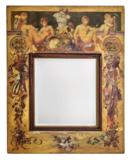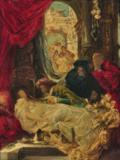Hans Makart

(Salzburg 1840–1884 Vienna)
Portrait of Henriette von Mankiewicz, around 1877/78, oil on panel, 105 x 77.5 cm, framed, (Rei)
Catalogued and illustrated in:
Emmerich Ranzoni, Makarts Werke, Heliogravuren nach den Original Gemälden, P. Bayer, Dresden 1889, ill. 44; Gerbert Frodl, Hans Makart, Monographie und Werkverzeichnis, Residenz Verlag, Salzburg 1974, p. 367, no. 306, ill. 74; Gerbert Frodl, Hans Makart, catalogue raisonné der Gemälde, published by Bibliothek der Provinz, Belvedere, Vienna 2013, p. 204, no. 360.
Provenance:
Hans Makart estate auction, H. O. Miethke, Vienna, 26. march 1885, lot 28, acquired by H. O. Miethke, Vienna; private property, The Netherlands.
Henriette Mankiewicz, daughter of the writer Josef Samuel Tauber, married Dresden banker and Consul General Carl Mankiewicz in 1872. Hans Makart was a friend of the couple, and together they visited the Bayreuth Festival. Henriette was a very successful artist in so-called silk shading, a combination of techniques including painting, embroidery and appliqué. She created large-format, decorative compositions with landscapes and flowers. The decorative bouquets of flowers in Makart’s late works may have served as a source of inspiration to her. For reasons hitherto unclear, Henriette’s portrait remained in the painter’s studio and was listed as part of the artist’s estate. As a result, it was sold at the major auction of Makart’s estate at the beginning of 1885 when it was bought by the well-known Viennese art dealer, H. O. Miethke.
Hans Makart portrayed ladies set against the background of a theatrical fantasy world which he created by depicting them in historical costumes taken from his extensive collection of props. His female sitters gladly complied as the painter was able, with infallible taste, to choose the costumes and matching accessories which suited the features of his models. It was the period known as Historicism, the epoch of the Vienna Ringstrasse, in which past times and styles were recalled in diverse ways, often influencing daily life. With its buildings evoking almost all architectural styles, the Ringstrasse most closely represents the architecture of the period. And in terms of the fine arts, it is the paintings of Hans Makart which indisputably symbolise that period better than any other. It is no accident that late 19th century Vienna is still referred to today as the Makartzeit, or ‘Makart’s Era’. The manner in which historical daydreams suffused social life is most clearly demonstrated in his portraits of women.
The portrait of Henriette Mankiewicz is as representative, theatrical and technically brilliant as is to be expected from this highly esteemed painter whose popularity extended far beyond the art world. He was a virtuoso of stage setting, both in the compositions of his portraits and the choice of costumes and jewels, as well as his painterly technique. The latter is remarkable for many reasons: he always chose variations of a specific colour that would dominate the portrait which he considered in keeping with the personality of his sitter: gold and white tones in the present work. At the same time, he also very skilfully accentuated the contrast between his pastose application of colour in the depiction of fabrics, jewellery and trim, and the smooth, delicate surface of the face and hands. The luxurious jewels Henriette wears in this portrait effectively contrast with her smooth, soft complexion. In the seeming contradiction between the thoughtfully arranged composition and its generous, often deliberately nonchalant painterly execution lies one of the greatest strengths of Hans Makart’s paintings.
Makart came to Vienna in 1869 after establishing himself as a successful young painter in Munich. The initial lack of important official commissions was largely counterbalanced by those he received from private clients to paint numerous portraits as well as large-scale room decorations, gigantic history paintings, theatre curtains, and much more. The grandiose style of his studio in the Gusshausstrasse soon attracted large numbers of visitors, becoming a centre of Viennese social life.
Specialist: Mag. Dimitra Reimüller
 Mag. Dimitra Reimüller
Mag. Dimitra Reimüller
+43-1-515 60-355
19c.paintings@dorotheum.at
23.04.2015 - 18:00
- Realized price: **
-
EUR 37,500.-
- Estimate:
-
EUR 35,000.- to EUR 45,000.-
Hans Makart
(Salzburg 1840–1884 Vienna)
Portrait of Henriette von Mankiewicz, around 1877/78, oil on panel, 105 x 77.5 cm, framed, (Rei)
Catalogued and illustrated in:
Emmerich Ranzoni, Makarts Werke, Heliogravuren nach den Original Gemälden, P. Bayer, Dresden 1889, ill. 44; Gerbert Frodl, Hans Makart, Monographie und Werkverzeichnis, Residenz Verlag, Salzburg 1974, p. 367, no. 306, ill. 74; Gerbert Frodl, Hans Makart, catalogue raisonné der Gemälde, published by Bibliothek der Provinz, Belvedere, Vienna 2013, p. 204, no. 360.
Provenance:
Hans Makart estate auction, H. O. Miethke, Vienna, 26. march 1885, lot 28, acquired by H. O. Miethke, Vienna; private property, The Netherlands.
Henriette Mankiewicz, daughter of the writer Josef Samuel Tauber, married Dresden banker and Consul General Carl Mankiewicz in 1872. Hans Makart was a friend of the couple, and together they visited the Bayreuth Festival. Henriette was a very successful artist in so-called silk shading, a combination of techniques including painting, embroidery and appliqué. She created large-format, decorative compositions with landscapes and flowers. The decorative bouquets of flowers in Makart’s late works may have served as a source of inspiration to her. For reasons hitherto unclear, Henriette’s portrait remained in the painter’s studio and was listed as part of the artist’s estate. As a result, it was sold at the major auction of Makart’s estate at the beginning of 1885 when it was bought by the well-known Viennese art dealer, H. O. Miethke.
Hans Makart portrayed ladies set against the background of a theatrical fantasy world which he created by depicting them in historical costumes taken from his extensive collection of props. His female sitters gladly complied as the painter was able, with infallible taste, to choose the costumes and matching accessories which suited the features of his models. It was the period known as Historicism, the epoch of the Vienna Ringstrasse, in which past times and styles were recalled in diverse ways, often influencing daily life. With its buildings evoking almost all architectural styles, the Ringstrasse most closely represents the architecture of the period. And in terms of the fine arts, it is the paintings of Hans Makart which indisputably symbolise that period better than any other. It is no accident that late 19th century Vienna is still referred to today as the Makartzeit, or ‘Makart’s Era’. The manner in which historical daydreams suffused social life is most clearly demonstrated in his portraits of women.
The portrait of Henriette Mankiewicz is as representative, theatrical and technically brilliant as is to be expected from this highly esteemed painter whose popularity extended far beyond the art world. He was a virtuoso of stage setting, both in the compositions of his portraits and the choice of costumes and jewels, as well as his painterly technique. The latter is remarkable for many reasons: he always chose variations of a specific colour that would dominate the portrait which he considered in keeping with the personality of his sitter: gold and white tones in the present work. At the same time, he also very skilfully accentuated the contrast between his pastose application of colour in the depiction of fabrics, jewellery and trim, and the smooth, delicate surface of the face and hands. The luxurious jewels Henriette wears in this portrait effectively contrast with her smooth, soft complexion. In the seeming contradiction between the thoughtfully arranged composition and its generous, often deliberately nonchalant painterly execution lies one of the greatest strengths of Hans Makart’s paintings.
Makart came to Vienna in 1869 after establishing himself as a successful young painter in Munich. The initial lack of important official commissions was largely counterbalanced by those he received from private clients to paint numerous portraits as well as large-scale room decorations, gigantic history paintings, theatre curtains, and much more. The grandiose style of his studio in the Gusshausstrasse soon attracted large numbers of visitors, becoming a centre of Viennese social life.
Specialist: Mag. Dimitra Reimüller
 Mag. Dimitra Reimüller
Mag. Dimitra Reimüller
+43-1-515 60-355
19c.paintings@dorotheum.at
|
Buyers hotline
Mon.-Fri.: 10.00am - 5.00pm
kundendienst@dorotheum.at +43 1 515 60 200 |
| Auction: | 19th Century Paintings |
| Auction type: | Saleroom auction |
| Date: | 23.04.2015 - 18:00 |
| Location: | Vienna | Palais Dorotheum |
| Exhibition: | 11.04. - 23.04.2015 |
** Purchase price incl. charges and taxes
It is not possible to turn in online buying orders anymore. The auction is in preparation or has been executed already.
More objects by this artist
-

Estimate:
EUR 8,000.- to EUR 12,000.- -

Estimate:
EUR 5,000.- to EUR 7,000.- -

Estimate:
EUR 1,300.- to EUR 1,800.-
